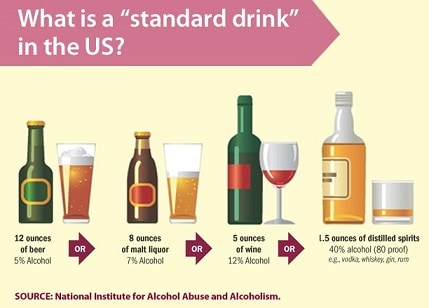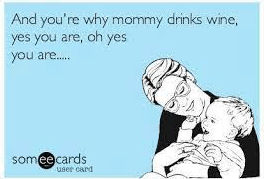Over the past few weeks in class, we’ve had conversations about alcohol use and risks associated with it. The NIAAA described the health risks associated with excessive drinkings such as heart disease, cancer, problems of the liver, pancreas and others such as sexually transmitted infections, violence, suicide. Most researchers believe that risks associated with alcohol drinking outweigh any potential health benefits from moderate drinking. As an example, Professor Walter Willett of epidemiology and nutrition at Harvard T.H. Chan School of Public Health thinks that heavy drinking is harmful.
What’s moderate drinking?

The CDC and NIAA defines the term “moderate drinking” as
1. Beer 12 ounces (5% alcohol content).
2. For malt liquor 8 ounces (7% alcohol content).
3. For wine 5 ounces (12% alcohol content).
4. 1.5 ounces or a “shot” of 80-proof (40% alcohol content) distilled spirits or liquor (e.g., gin, rum, vodka, whisk
A new study on Alcohol: Balancing Risks and Benefits concluded that there’s no amount of alcohol consumption that’s safe for overall health — a finding that’s likely to surprise moderate drinkers, and that has left some experts unconvinced.
The federal, state and local authorities in the US work together to minimize health risks associated with alcohol drinking.
In this blog, I’m sharing some of the alcohol prevention strategies I’ve learned for the past few weeks while taking a class in Special topics in Epidemiology on alcohol and women.
- Prohibitions of alcohol sponsorship of public events – Alcohol sponsorship by alcohol companies has been a debated issue in recent months. According to a Sponsorship Today report, more than $1 billion was spent on sports sponsorships by beer companies alone in 2012. prohibition by integrating sports sponsorship with responsible consumption messages.
- Increases in price through excise taxes –Increase taxes have consistently been found to reduce alcohol consumption and problems, especially among youth. Alcohol excise taxes affect the price of alcohol and are intended to reduce alcohol-related harms, raise revenue, or both. Alcohol taxes are implemented at the state and federal level, and are beverage-specific (i.e., they differ for beer, wine, and spirits). In the US, Alabama and Washington’s state have some of the highest taxes on alcohol
- Controls on alcohol advertising (especially on billboards, sides of buses, and in other public areas)-The alcohol industry are among the leading advertisers on billboards. Billboards advertising beer and hard liquor are readily visible to children. These advertisements expose and encourage excessive drinking among youth. Laws of Billboard advertisement in Georgia prohibits advertising alcoholic drinks and tobacco products at children, educational and medical institutions, culture and sports organizations within 100 meters radius of them is prohibited.

- Limiting hours of sale: –Another strategy to prevent excessive alcohol consumption and related harms is to limit access by limiting the hours during which alcohol can legally be sold. In the US they differ from one state to another. In Atlanta, Georgia, packaged liquor may be sold between 12:30 p.m. and 11:30 p.m. on Sunday, and between 8:00 a.m. and 11:45 p.m., Monday through Saturday. Packaged beer and wine may be sold at any time except between midnight Saturday night and 12:30 p.m. Sunday afternoon, or between 11:30 p.m. Sunday night and 12:01 a.m. on Monday. Alcoholic beverages may be served in bars and restaurants between 12:30 p.m. and midnight on Sunday, and between 9:00 a.m. and 2:30 a.m., Monday through Saturday.
Should we make these strategies different for women and men?
The answer to this question is YES. Alcohol offers each group a different spectrum of risks. It is necessary for everyone, especially policymakers to understand that alcohol affects women’s bodies differently. Unlike males, women are more likely to suffer the health and social effects of alcohol consumption. Also, women are vulnerable to the secondhand effects or alcohol harms of excessive alcohol consumption among others.
With a recent report on an increase in the number of women who drink, there should be an awareness of these health risks and make informed decisions about alcohol use. As such, it should be given special attention.
We also need to be aware that women are the target for more recent alcohol ads and campaigns. Advertisers market liquor as “diet” or “natural” in an effort to appeal to health-conscious women.
















 Guilty that they were so difficult to parent that their mothers spent years in rehab? Comfortable with the idea that drinking is for parents, perpetuating the cycle of parental alcohol use disorders? Confused about why the 2010s was a decade full of mothers turning to alcohol in a comfortably sassy advertising climate? This future holds a whole new host of adolescent trauma.
Guilty that they were so difficult to parent that their mothers spent years in rehab? Comfortable with the idea that drinking is for parents, perpetuating the cycle of parental alcohol use disorders? Confused about why the 2010s was a decade full of mothers turning to alcohol in a comfortably sassy advertising climate? This future holds a whole new host of adolescent trauma.




 Similarly, another meme featuring celebrity Aubrey Plaza chugging from a wine bottle says “Just when I think I cant take it anymore… But then I remembered that alcohol existed.” Grammar aside, this makes reference to at best a tough day and at worst depression and other mental health concerns like suicide. Plaza is a comedic actor known for taking roles with dramatic substance and alcohol consumption central to the
Similarly, another meme featuring celebrity Aubrey Plaza chugging from a wine bottle says “Just when I think I cant take it anymore… But then I remembered that alcohol existed.” Grammar aside, this makes reference to at best a tough day and at worst depression and other mental health concerns like suicide. Plaza is a comedic actor known for taking roles with dramatic substance and alcohol consumption central to the  Peer pressure is another form of negative reinforcement that encourages women to drink more. This meme “I saw a husband cheering on his wife to chug her margarita at dinner….that’s the type of relationship I want.” Is scary for many reasons. When there is a mismatch of genders present when alcohol is consumed it often is more dangerous for the women than the men. While this meme clearly describes a married couple, domestic violence and sober consent are still issues at play. If you removed the ‘husband’ and ‘wife’ from this scenario it sounds like a predatory man trying to get a women drunk for potentially nefarious reasons…and the onlooker being envious of this situation. While this is likely not the case here, the meme still normalizes chugging of hard liquor and makes it sound like an ideal significant other is one who encourages you to do so.
Peer pressure is another form of negative reinforcement that encourages women to drink more. This meme “I saw a husband cheering on his wife to chug her margarita at dinner….that’s the type of relationship I want.” Is scary for many reasons. When there is a mismatch of genders present when alcohol is consumed it often is more dangerous for the women than the men. While this meme clearly describes a married couple, domestic violence and sober consent are still issues at play. If you removed the ‘husband’ and ‘wife’ from this scenario it sounds like a predatory man trying to get a women drunk for potentially nefarious reasons…and the onlooker being envious of this situation. While this is likely not the case here, the meme still normalizes chugging of hard liquor and makes it sound like an ideal significant other is one who encourages you to do so. Recently, posts by twitter users have been screenshot and turned into memes. “One time when I was drunk a guy asked me if I’d go on a date with him and I said ‘ok! But when I’m sober I’m not going to want to anymore’ and I think about that a lot.” This one delves deeper into the potentially dangerous situations women can end up in when making inebriated decisions. Dangerous or not, they are often decisions women just don’t want to be in. This author at least is self reflecting and acknowledging the difference between her sober and drunk decision making, but this example is unique in that her reflection came while drunk – not the next day when hungover wondering why the night before turned out as it did.
Recently, posts by twitter users have been screenshot and turned into memes. “One time when I was drunk a guy asked me if I’d go on a date with him and I said ‘ok! But when I’m sober I’m not going to want to anymore’ and I think about that a lot.” This one delves deeper into the potentially dangerous situations women can end up in when making inebriated decisions. Dangerous or not, they are often decisions women just don’t want to be in. This author at least is self reflecting and acknowledging the difference between her sober and drunk decision making, but this example is unique in that her reflection came while drunk – not the next day when hungover wondering why the night before turned out as it did.



